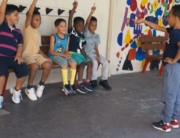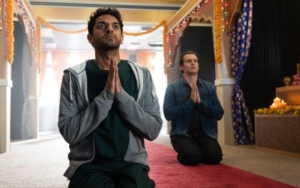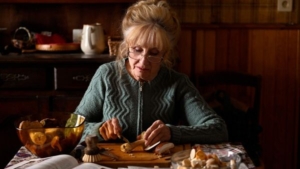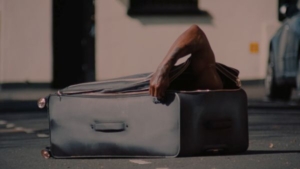This year, the two best films made by first-time feature filmmakers at Cannes were animated, The Red Turtle and My Life as a Courgette (as in zucchini). This is not coincidental. Given the budget demands and the time span needed to produce high-quality animation, very little can be left to chance; things must be planned well ahead of time. (Courgette took seven years to make, for example.)
Give credit, then, to the storyboard. Both movies are told with precision but without rigidity. In both cases, you won’t know where the free-flowing story is headed. Nor do they contain fat. Turtle runs at a speedy 80 minutes and Courgette a spry 62 minutes, yet more plot and character development occur in these films than in most of the selections in the festival. This was especially true for those seen in the International Critics’ Week sidebar.
The Red Turtle’s Dutch director, Michael Dudok de Wit, has an additional end credit, for storyboarding his European/Japanese coproduction produced under the banner of the celebrated Studio Ghibli. Not to start an argument, but this may be the most gorgeously drawn film of the last 10 years (though I felt the same way about The Tale of the Princess Kaguya), with its clean lines and shifting color palettes: gray stones set against a pale blue sea, a verdant bamboo forest of multiple shades of greens, and the black-and-white, pen-and-inklike nighttime sequences.
This subdued circular tale of man intertwined with nature first centers on a lone man who has washed up on a deserted island, uninhabited except for crabs and other aquatic creatures, after surviving a tempest that sunk his ship. From bamboo stalks, the Robinson Crusoe stand-in constructs a raft and sets out to sea toward the coastline far in the horizon. Each attempt is thwarted, though, by something swimming below the rickety raft that bashes into it, smashing it to smithereens.
During the third attempt, he sees the culprit wading to the surface, a red-shelled turtle. Even its skin has a vermillion tinge. After the man swims back to land, the turtle follows him onto the beach and, out of his frustration, he clubs the animal and turns it over onto its back and leaves it to die. Instead, though, its shell cracks open to reveal that the reptile has transformed into a beautiful, henna-haired woman. When it rains, she comes to life: she’s Venus in a tortoise shell.
The Red Turtle goes back to film’s roots, relying mostly on visual storytelling, jettisoning dialogue while set to a score that combines the orchestral swoons of John Barry and the best of James Horner. It’s a work of beauty; the underwater swimming sequences have the fluidity of ballet, and it is continuously eye-catching, with a simple story line that should easily cross borders. Don’t be surprised if it winds up nominated for the best animated film Oscar, up against a few Hollywood blockbusters.
Though his real name is Icare, a nine-year-old French boy goes by the nickname his mother gave him, Courgette, the summer squash. So perhaps it’s fitting that in the stop-motion My Life as a Courgette, he sort of looks like the offspring of Mr. Potato Head: he has a large head and huge blue eyes. (Director Claude Barras said he magnified that facial feature to reveal more emotion, magnifying the maxim that the eyes are the key to the soul.) The boy also has a shock of blue hair and a red nose and ears, but, rest assured, Barras keeps the cute factor in line. His movie is moving, rather than sentimental, and spiked with tartness. It’s based on the novel Autobiography of a Courgette by Gilles Paris, adapted by Céline Sciamma, writer/director of other perceptive coming-of-agers, Tomboy and Water Lilies.
Courgette’s mother spends her afternoons watching soaps and drinking copious cans of beer, until her untimely death in an accident, for which her son blames himself. Now a ward of the state, he becomes the new kid at a group home, and he brings with him one cherished memento of his mother: an empty can of beer.
The wide-eyed, observant tone doesn’t capsize into the dark side, despite the backstories of the housemates: Simon’s parents died of drug overdose, and one girl’s father sexually abused her, though the others kids don’t quite understand what happened. The children are constantly testing and teasing each other—Courgette’s name being an easy target for jokes—but when push comes to shove, everyone, whether a kid or a divorced dad, wants to belong and have a second chance. (Children really do know what they want, though they don’t necessarily know how to express it.) The animation is simple and no-frills, but the movie’s strength lies in its hopeful, and not naïve, outlook and its convincing evocation of childhood.
It would be a shame if some of its humor kept the film out of reach of kids outside of France, where it is set for a summer release; Simon teaches Courgette the birds and bees based on his knowledge of his folks’ porn collection, which involves men tiring out and women agreeing a lot, “oui, oui, oui.” There’s also a flash of puppet nudity as part of the kids’ bewildered reaction to adult anatomy. That’s in keeping with the storytelling and voice acting that come across as realistic and off-the-cuff; you’ll forget that this movie is made with puppets.
Of all of the festival films I attended with the filmmaker present, this one received the strongest ovation for the director, which went on for several minutes.


















Leave A Comment